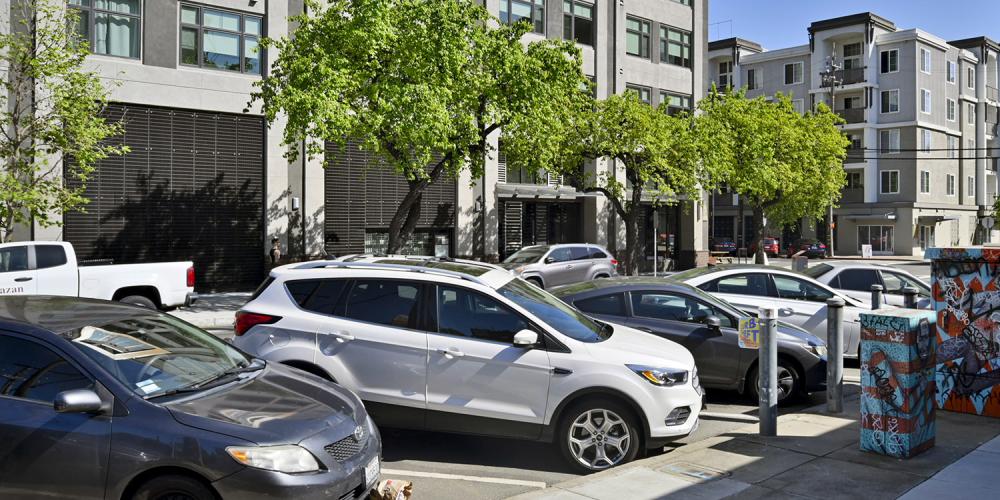
Why Consider a Parking & Transportation Demand Management (PTDM) Policy?
Key reasons for developing a PTDM Policy include:
- Supporting a jurisdiction’s compliance with Senate Bill 743 and the adoption of related Vehicle Miles Traveled (VMT) thresholds and screens for transportation impacts, potentially serving as a California Environmental Quality Act (CEQA) VMT impact mitigation strategy
- Requiring land use development to encourage travel by transit, walking and bicycling through implementation of supportive on-site infrastructure and design, as well as through benefits and programs for project employees and/or residents
- Right-sizing parking requirements to reduce the cost of construction and commercial or residential rents and ensure more efficient use of land and other community resources
- Supporting the jurisdiction’s designation as a Connected Community Priority Development Area (PDA) and access to related MTC funding opportunities, if adopted in concert with a VMT impact or in-lieu fee (VMT Fee)
What is a PTDM Policy?
A PTDM Policy requires new land use developments to implement measures that can reduce automobile trips and VMT. PTDM strategies support travel by transit, walking and bicycling and discourage drive-alone trips. PTDM Policies generally apply to all new developments in a jurisdiction, with different levels of VMT or trip reductions required based on the characteristics of individual development projects and their location or context to maximize the benefits of a more multimodal and sustainable transportation system.
PTDM strategies should align with broader planning goals for improving mobility access, safety and affordability. Measures may include provision of subsidized transit passes, subsidized car share and bike share membership, access to end-of-trip bicycle facilities, parking cash-out programs and unbundled parking. Right-sizing parking requirements can also lower the cost of construction and commercial or residential rents and ensure more efficient use of land and other community resources. Jurisdictions can also develop a VMT fee to complement a PTDM Policy by providing a funding mechanism for off-site VMT-reducing transportation improvements like transit, bicycle and pedestrian projects.
Senate Bill 743 (SB 743) requires lead agencies not to use measures of vehicle delay (such as Level of Service or LOS) as environmental impact criteria, and instead to use VMT to better align transportation impact criteria with state environmental, economic and public health goals. The PTDM Policy supports compliance with SB 743 and adoption of VMT thresholds and screens. VMT mitigation requires reducing the number and distance of vehicle trips generated by a particular project and may take the form of PTDM measures. PTDM Policies can list the measures for CEQA mitigation, some of which, depending on the fee structure, may be addressed with an associated VMT fee. Find VMT policies and resources by county.
Core elements of PTDM Policy development include, but are not limited to:
- Establishment of performance targets associated with VMT, potentially varying by location and project characteristics
- Identification of PTDM measures available to project applicants, including site-specific programs and on-site infrastructure improvements
- Establishment of monitoring criteria to ensure program success
- Assessment of how the jurisdiction’s existing off-street parking requirements and policies may be modified to support the goals of the PTDM Policy
Jurisdictions with a Connected Community PDA may use a PTDM Policy and complementary VMT impact fee or in-lieu fee for off-site improvements to satisfy MTC’s VMT reduction planning requirements for Connected Community PDAs.
What Kinds of Communities Should Consider Developing a PTDM Policy?
- Communities with substantial demand for new development
- Communities interested in supporting non-automobile travel through project design and on-site improvements at new land use developments
- Communities where new development projects are likely to result in significant CEQA impacts related to VMT
Key Planning Steps
The steps to develop a PTDM Policy are listed below. Refer to the PTDM Policy Development Guide for more detailed guidance.
- Establish leadership and clarify policy objectives
- Identify a champion
- Convene a working group
- Identify and contact stakeholders
- Determine whether the PTDM policy will be used as a CEQA mitigation strategy
- Solicit consultant services if desired
- Develop and release an RFP (PTDM Request for Proposals Template)
- Review proposals and select a consultant
- Finalize the contract
- Develop the policy (see scope of work in the PTDM Request for Proposals Template)
- Develop a stakeholder engagement plan
- Collect data and/or facilitate access to data sources
- Review existing plans and policies and understand connections to new plans and policies
- Establish performance targets for development projects
- Identify a toolbox of PTDM strategies and methods for estimating and monitoring effectiveness (see Handbook for Analyzing Greenhouse Gas Emission Reductions, Assessing Climate Vulnerabilities, and Advancing Health and Equity)
- Establish monitoring requirements
- Develop the policy document
- Implement the policy
- Identify the regulatory platform for the PTDM Policy
- Draft staff reports to support council action
- Monitor progress and update the policy
Sample Documents
In addition to the guidance linked in the key planning steps above, the following sample documents are provided:
- Sample PTDM Policies and Ordinances
- Sample Existing Conditions
- Sample Resolutions
- Sample Staff Reports
Policy Tools
In addition to the guidance and samples, the following tools to support policy development and implementation are provided:

